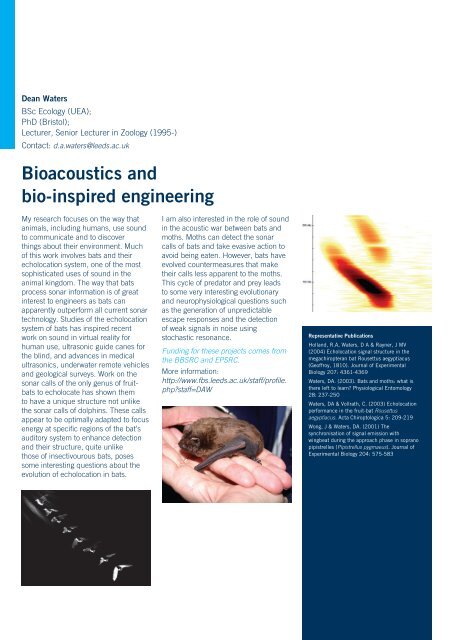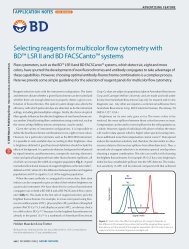3649-08 IICB.indd - Faculty of Biological Sciences - University of ...
3649-08 IICB.indd - Faculty of Biological Sciences - University of ...
3649-08 IICB.indd - Faculty of Biological Sciences - University of ...
You also want an ePaper? Increase the reach of your titles
YUMPU automatically turns print PDFs into web optimized ePapers that Google loves.
Dean Waters<br />
BSc Ecology (UEA);<br />
PhD (Bristol);<br />
Lecturer, Senior Lecturer in Zoology (1995-)<br />
Contact: d.a.waters@leeds.ac.uk<br />
Bioacoustics and<br />
bio-inspired engineering<br />
My research focuses on the way that<br />
animals, including humans, use sound<br />
to communicate and to discover<br />
things about their environment. Much<br />
<strong>of</strong> this work involves bats and their<br />
echolocation system, one <strong>of</strong> the most<br />
sophisticated uses <strong>of</strong> sound in the<br />
animal kingdom. The way that bats<br />
process sonar information is <strong>of</strong> great<br />
interest to engineers as bats can<br />
apparently outperform all current sonar<br />
technology. Studies <strong>of</strong> the echolocation<br />
system <strong>of</strong> bats has inspired recent<br />
work on sound in virtual reality for<br />
human use, ultrasonic guide canes for<br />
the blind, and advances in medical<br />
ultrasonics, underwater remote vehicles<br />
and geological surveys. Work on the<br />
sonar calls <strong>of</strong> the only genus <strong>of</strong> fruitbats<br />
to echolocate has shown them<br />
to have a unique structure not unlike<br />
the sonar calls <strong>of</strong> dolphins. These calls<br />
appear to be optimally adapted to focus<br />
energy at specific regions <strong>of</strong> the bat’s<br />
auditory system to enhance detection<br />
and their structure, quite unlike<br />
those <strong>of</strong> insectivourous bats, poses<br />
some interesting questions about the<br />
evolution <strong>of</strong> echolocation in bats.<br />
I am also interested in the role <strong>of</strong> sound<br />
in the acoustic war between bats and<br />
moths. Moths can detect the sonar<br />
calls <strong>of</strong> bats and take evasive action to<br />
avoid being eaten. However, bats have<br />
evolved countermeasures that make<br />
their calls less apparent to the moths.<br />
This cycle <strong>of</strong> predator and prey leads<br />
to some very interesting evolutionary<br />
and neurophysiological questions such<br />
as the generation <strong>of</strong> unpredictable<br />
escape responses and the detection<br />
<strong>of</strong> weak signals in noise using<br />
stochastic resonance.<br />
Funding for these projects comes from<br />
the BBSRC and EPSRC.<br />
More information:<br />
http://www.fbs.leeds.ac.uk/staff/pr<strong>of</strong>ile.<br />
php?staff=DAW<br />
Representative Publications<br />
Holland, R.A, Waters, D A & Rayner, J MV<br />
(2004) Echolocation signal structure in the<br />
megachiropteran bat Rousettus aegyptiacus<br />
(Ge<strong>of</strong>froy, 1810). Journal <strong>of</strong> Experimental<br />
Biology 207: 4361-4369<br />
Waters, DA. (2003). Bats and moths: what is<br />
there left to learn? Physiological Entomology<br />
28: 237-250<br />
Waters, DA & Vollrath, C. (2003) Echolocation<br />
performance in the fruit-bat Rousettus<br />
aegyptiacus. Acta Chiroptologica 5: 209-219<br />
Wong, J & Waters, DA. (2001) The<br />
synchronisation <strong>of</strong> signal emission with<br />
wingbeat during the approach phase in soprano<br />
pipistrelles (Pipistrellus pygmaeus). Journal <strong>of</strong><br />
Experimental Biology 204: 575-583










